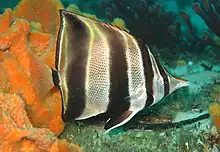| Chelmonops truncatus | |
|---|---|
 | |
| Scientific classification | |
| Domain: | Eukaryota |
| Kingdom: | Animalia |
| Phylum: | Chordata |
| Class: | Actinopterygii |
| Order: | Perciformes |
| Family: | Chaetodontidae |
| Genus: | Chelmonops |
| Species: | C. truncatus |
| Binomial name | |
| Chelmonops truncatus | |
| Synonyms[3] | |
| |
Chelmonops truncatus, the eastern talma or truncate coralfish, is a species of marine ray-finned fish, a butterflyfish from the family Chaetodontidae. It is endemic to Australia.[4]
Description
Chelmonops truncatus bears a close resemblance to the Western talma (C. curiosus), the main difference being that the dorsal fin is truncated, compared to the long filament present on the western species. The fins and dark bands on the body are often tinged vinaceous, giving them a dark, red appearance in some light. Like other butterflyfishes the juveniles have an obvious ocellus on the dorsal fin, but this smudges and becomes less obvious as the fish matures. The smooth profile of the rear part of the dorsal fin is more obvious in younger fish, and this part of the fin becomes slightly elongated in adults.[5] The rear margin of the soft dorsal and anal fins is almost vertical in adults, the fins are more rounded in juveniles.[6] This species attains a maximum total length of 22 centimetres (8.7 in).[3]
Distribution
Chelmonops truncatus is endemic to south eastern Australia where it occurs from Double Island Point in southern Queensland south to around Jervis Bay in New South Wales.[6]
Habitat and biology
Chelmonops truncatus is found in coastal bays and estuaries where they live along deep rocky walls. The adults are normally found in pairs, while the juveniles are frequently encountered alone. Their diet comprises small crustaceans, worms, and filamentous algae.[1] Pairs defend territories.[7]
Utilisation
Chelmonops truncatus is rare in the aquarium trade and is almost never exported from Australia.[5]
Taxonomy
Chelmonops truncatus was first formally described in 1859 as Chaetodon truncatus by the austrian ichthyologist Rudolf Kner (1810-1869) with the type locality given as Sydney.[8] The Dutch ichthyologist Pieter Bleeker (1819-1878) created the genus Chelmonops in 1876 as a monotypic genus with this species as its only member. C. truncatus is, therefore, the type species of Chelmonops.[9]
References
- 1 2 Myers, R.F.; Pratchett, M. (2010). "Chelmonops truncatus". IUCN Red List of Threatened Species. 2010: e.T165720A6101640. doi:10.2305/IUCN.UK.2010-4.RLTS.T165720A6101640.en. Retrieved 20 November 2021.
- ↑ "Australianmuseum.net.au". Retrieved 16 July 2010.
- 1 2 Froese, Rainer; Pauly, Daniel (eds.) (2019). "Chelmonops truncatus" in FishBase. December 2019 version.
- ↑ "OzAnimals.com". Retrieved 16 July 2010.
- 1 2 Lemon, T.Y.K. (2015). "The long-nosed butterflies part 1: Chelmon and Chelmonops". Reefs.com. Retrieved 22 November 2020.
- 1 2 Bray, Dianne. "Eastern Talma, Chelmonops truncatus". Fishes of Australia. Retrieved 29 September 2014.
- ↑ "Chelmonops truncatus". Saltcorner. Bob Goemans. 2012. Retrieved 22 November 2020.
- ↑ Eschmeyer, William N.; Fricke, Ron & van der Laan, Richard (eds.). "Chaetodon truncatus". Catalog of Fishes. California Academy of Sciences. Retrieved 22 November 2020.
- ↑ Eschmeyer, William N.; Fricke, Ron & van der Laan, Richard (eds.). "Genera in the family Chaetodontidae". Catalog of Fishes. California Academy of Sciences. Retrieved 22 November 2020.
Further reading
- Care information for Truncate coralfish at the Aquarium wiki
- Edgar, G.J. (1997). Australian Marine Life; the plants and animals of temperate waters. Reed Books. Pp. 544.
- Kuiter, R. H. in Gomon, M.F., Glover, C.J.M. & R.H. Kuiter (Eds). 1994. The Fishes of Australia's South Coast. State Print, Adelaide. Pp. 992. (asSquareback Butterflyfish)
- Hutchins, B. & R. Swainston. 1986. Sea Fishes of Southern Australia. Complete Field Guide for Anglers and Divers. Swainston Publishing. Pp. 180.
- Kuiter, R.H. 1996. Guide to Sea Fishes of Australia. New Holland. Pp. 433.
- Kuiter, R.H. (2000). Coastal Fishes of South-eastern Australia. Gary Allen. Pp. 437.
